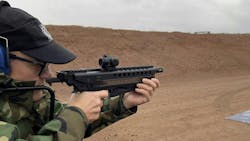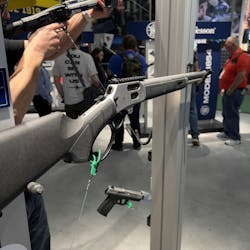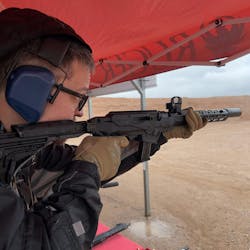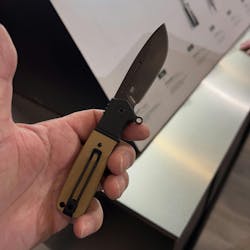Looking Back on SHOT Show 2024
SHOT Show 2024 is over, and it was the coolest ever. I know, I know, I say this every year. I met new friends and got to visit old friends too. This year, I spent time on two different ranges, and wet conditions turned out to be advantageous. The first range I visited was hosted by Beretta. It was a private affair, and I got to spend a little more time than usual with their products. Let’s put it this way, I shot almost five boxes of shotgun shells, most of which went through my new favorite sporting gun, the Beretta A300. A300 models are made in the USA, and they feature a recoil-reducing system called Kick-Off, which works well.
This article appeared in the March/April issue of OFFICER Magazine. Click Here to subscribe to OFFICER Magazine.
I shot my favorite 32 Auto, the Tomcat, under its new designation, the Beretta 30X. It has an improved trigger and push button tip-up barrel.
On the 9mm side, I shot the Model 92 variants. The Beretta 92GTS (I think “TS” stands for “twin sear”) has a frame-mounted decocker that drops the hammer to half cock. Not only did it have the usual Beretta smoothness, steel plates were felled in a panic under its authority.
Langdon Tactical had a Beretta LTT 1301, a Beretta 1301 with an improved trigger, MagPul furniture, and their improved lifter. I tried to play some music with it on the steel targets.
On the SHOT Show Media Day range, I shot dozens of new guns. There really wasn’t a trend, except it seems as if everyone released a lever gun this year. I have highlighted the two that stood out for me, but there were plenty of others. OFFICER Editorial Director Frank Borelli and I agree on this: The lever gun is a viable gun for law enforcement, and the newer models have more utility for the job.
Lever action
Henry released its LASR (Lever Action Supreme Rifle) and it looks like a traditional lever gun, but it has an internal hammer and an unusual bolt. The bolt face is an AR-15 bolt face, and, if I am betting that many of the internals are interchangeable with the AR. It takes AR-style magazines. The debut model comes in .223 and .300 BLK. While Daniel was showing me the features of this gun, I noticed that the 18” barrel was free-floated in the walnut hand guard. Besides the fact that this gun is absolutely gorgeous, it has great utility for lots of applications, including law enforcement. The receiver is already drilled and tapped for scope mounting, which also means accessory optics and backup sights. The barrel is threaded. In fact, the model they had on the range was suppressed. One of my house guns is a Henry, but the LASR action is smoother, and it seems shorter. The LASR is ambidextrous, including the tang safety.
Smith & Wesson also had a lever action on the shot show floor, the model 1854. This is Smith & Wesson’s first plunge in a lever action rifle, although it definitely pays tribute to the origins of the company. It comes in 44 Remington Magnum and has a 9+1 capacity. Most will probably go for the traditional-looking lever gun with the high-grade walnut furniture. I definitely gravitated toward the subdued finish model with the black PVD stocks.
R.I.A. 5.0 E (The ‘E’ stands for ‘enhanced’)
I’ve had a chance to test several RIA models over the past few years, so I figured the Rock Island folks were all out of surprises. I was wrong. The RIA 5.0 E is a 17-round semi that places the axis of the barrel so closely into the web of the hand that it literally feels like a mounted extension. This is the kind of design where the frame profile wraps around the slide, and much of the recoil impulse goes rearward, rather than up. I would wager to say that this gun will outperform most integrally compensated guns on the market.
The frame is metal, but the grip portion is glass-filled nylon, giving it a comfortable platform where gun-meets-flesh. The 5.0 E comes standard with night sights, and I understand they are SIG pattern, which opens up a huge inventory of sights available for it. It also comes with an RMR cut.
Most gun companies talk about their deep commitment toward American manufacturing and the American gun market, but RIA showed they walk the talk. Plant Manager Lynn, and Programmer Daycen were on the range, demonstrating the product. Lynn told me the RIA 5.0E is made in Cedar City, Utah, in a small plant. Much of this product is fitted by hand. There was never a crew like the RIA team with their enthusiasm about their products.
The action and trigger of the RIA 5.0E is amazingly smooth. Not only is the recoil gentler, the action in its full extension has a lighter lockup, a feature usually found with a lighter slide or heavier gun. In the case of the 5.0E, it is just a superior design. Because of this, it was a grace note faster than conventional 9mm handguns. I would definitely put this gun on duty.
Kel-Tec P50 Defender
Kel-Tec released the P50 Defender sometime late last year, and this was my first opportunity to shoot it. The P50 Defender is the R50 with a 9.6” barrel, making it a bit handier than the 16.5” model. The P50 Defender, a 5.7 x 28mm pistol length gun uses FN P90 style magazines, which are made by Pro Mag for Kel-Tec. The magazines hold 50 rounds, perfect for a sub-gun-sized defensive tool. The P50 Defender has a side folding stock, and weighs 4.3 lbs. The 5.7 x 28mm round is very light, and has outstanding accuracy, mostly because of its high velocity and low recoil.
5.7 x 28 is growing in popularity, and it can be attributed to the fact that an average shooter can send a large volume of accurate fire downrange in seconds. If I had to form an ad hoc team to respond to a shooting in progress, a team armed with these would be well-equipped.
I would have preferred they filled the magazine to capacity when I tested this gun. It was incredibly easy to stay on target.
5.11 V.XI Collection
On the floor, I went by the 5.11 booth, and was fortunate to meet Eric Tietje, who walked me through the V.XI Collection, probably the most advanced integrated uniform solution on the market today. The XTU pants had an internal Ortholite knee pad with a semi-rigid outer knee pad. Both the inner and outer knee pads are removable. The outer one, which is articulated, uses a series of clips that run around the perimeter. They stay clipped in and bend with the knee. 5.11 recognized that knee pads get caught on things, and the tear-away feature is really an advantage. Eric told me that some wearers have started to ask to be able to swap pads from other XTU color schemes so they have contrasting pads. End users don’t have to buy the pads separately. They come with the pants.
The XTU Pant has a Ortholite foam support at the back of the waistband, which is a natural gun belt pad. They are made of a Cordura cotton blend. This material has a stretch quality, and comfortable feel.
The V.XI Sigurd shirt is a performance base layer made of nylon and elastane with Cryo-Tac technology, which maintains body temperature by allowing breathability. This shirt feels more like a rash guard than a uniform shirt, and the against-the-skin feel is comfy. 5.11 really paid attention to their users by adding a rugby type of collar that can fold up or down. The material has a friction-reducing finish. Anyone who has had a long gun on a sling will appreciate this collar.
Eric showed me the XTU LT3 jacket, a PrimaLoft insulated, fully articulated garment that was very low bulk and a water-resistant finish.
Ruger LC45 Carbine
We shot the Ruger LC Carbine in 45 Auto. This is a fully ambidextrous lightweight carbine with a 16.25” barrel and adjustable folding stock. The charging handle is reversible. The LC Carbine takes Glock pattern magazines, and it can mount standard Picatinny rail accessories.
Smith & Wesson M&P FPC Carbine
Smith & Wesson has released a series of M&P FPC Carbines. The one they had on the SHOT Show floor was a 9mm that looked like an M&P pistol with a long barrel and folding stock. It is compatible with the pistol magazines, too. This carbine is optics and accessories compatible, and a magazine stores in the stock. For an M&P-equipped officer, this is the way to go.
Case Longhouse
I looked at quite a few knives, but most of them were just different variations on the same theme. Some of these variations really caught my eye. For example, Spyderco has a Paramilitary 2 in their SALT Series. There’s no question in my mind: This knife was conceived for the guys with rectangles over their eyes.
The Case Longhouse is new, and I have to get one. I’m going to say this again: I do not like flipper knives. The Longhouse is a flipper, but it is different. Most flippers have the flipper part on the non-opening side. The advantage is that it makes a finger guard when open. The disadvantage is the fact that I have cut myself several times on flippers that opened when I did not want them opened.
The Longhouse uses CPM20CV steel, which has a matte finish. It sports a deep pocket clip. The models I got to see were micarta or rosewood scales. I honestly don’t know which I like better. The rosewood is deep red, and it really honors the deep Case knife making heritage. I like micarta, and Case has two micarta choices.
The Longhouse is a front flipper, and the ball-bearing pivot allows it to open smoothly, playing with it is addicting. As a working knife, the clip blade has great utility and strength, while retaining the look of a gentlemen’s knife.
There were plenty of new innovations, but I only have a certain amount of column space. My son and I took plenty of photos, so at least you will have a picture of the magnitude of the SHOT Show. I promise that some of the products that I viewed will get reviewed this year.
About the Author
Lindsey Bertomen, a retired police officer and military small arms trainer, has taught shooting techniques for over a decade, in addition to teaching criminal justice at Hartnell College in Salinas, California. Off the clock he enjoys competing in shooting sports, running and cycle events. He welcomes comments at [email protected].
This article appeared in the March/April issue of OFFICER Magazine.
About the Author

Officer Lindsey Bertomen (ret.), Contributing Editor
Lindsey Bertomen is a retired police officer and retired military small arms trainer. He teaches criminal justice at Hartnell College in Salinas, California, where serves as a POST administrator and firearms instructor. He also teaches civilian firearms classes, enjoys fly fishing, martial arts, and mountain biking. His articles have appeared in print and online for over two decades.



